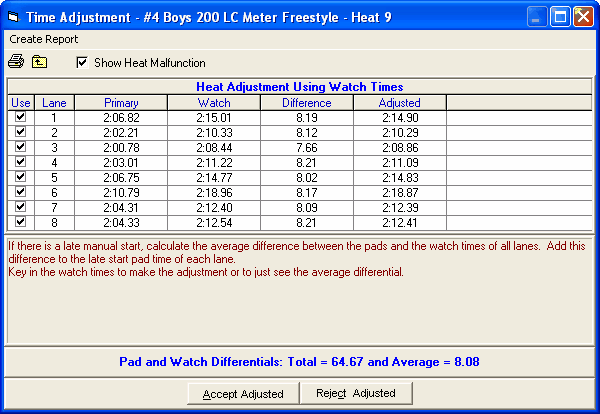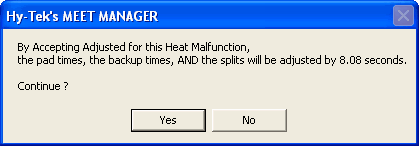There are two types of heat malfunctions:
•Late Start: There is a late start of the electronic timer and valid finishes are recorded with the pads and/or buttons and watches.
•No Start: There is no start of the timer and there are only watch times with NO pad and NO button times.
Adjustment for Malfunction Equally Affecting an Entire Heat
If there is an early or late start of the electronic timer and the times from the pads are equally incorrect for all the lanes in a heat and the order of finish and the absolute difference of the times between the swimmers is accurate, the times of the primary system shall be adjusted. This adjustment is calculated by taking the average difference between the primary times (the pads) and the valid backup times (the watches) and adding or subtracting the difference to the primary time of every lane in the heat.
In the example below, there was a late start for the timer of about 8 seconds. The average watch time for each lane was entered and the Time Adjustment is made. In the example, 8.03 seconds is added to each lane. To display the Time Adjustment window, select the heat from the Run Menu and press Ctrl-K. Then click the 'Show Heat Malfunction' check box. Enter the watch times and then click Accept Adjusted.
If Accept Adjusted is chosen, the following message appears:
What to do if there also was a Bad Touch
If in addition to the late start there was a bad touch on a lane, but there was a good button time, go ahead and make the heat adjustment above and then use then adjust the bad touch lane using the Lane Malfunction routine.
Adjustment for Timer Failure Affecting an Entire Heat
If there is a total timer failure of a heat where there are no pad or button backup times and you only have watch times, then the following procedures may be followed:
•Select several heats in the same event or a comparable event and use the Heat Malfunction method described above to enter the average watch times so that watch differentials can be calculated. Do this for 3 or 4 heats.
•Compute the average of the average differential from the 3 or 4 heats.
•Add this average to each of the watch times in the heat where the total malfunction occurred and manually enter these adjusted watch times into the pad times column at the bottom of the Run Menu.

